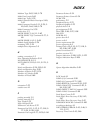
Glossary
G-10 Maxtor Atlas 10K V
SCSI BUS – A multi-signal parallel bus that
interconnects SCSI devices in a daisy-chain
fashion.
SCSI DEVICE – A host adapter or a target
controller that can be attached to the SCSI bus.
SCSI ID – The bit-significant representation of
the SCSI address referring to one of eight (or
one of sixteen) data lines.
SECTOR – On a PC hard drive, the minimum
segment of track length that can be assigned to
store information. On Macintosh and UNIX
drives, sectors are usually grouped into blocks
or logical blocks that function as the smallest
data unit permitted. Since these blocks are often
defined as a single sector the terms block and
sector are sometimes used interchangeably in
this context. (Note: The usage of the term
block in connection with the physical
configuration of the disk is different from its
meaning at the system level. See also
block and
cluster for comparison.)
SEEK – A movement of the disk read/write
head to a specific data track.
SEGMENTED CACHE BUFFER – A cache
buffer that is organized into multiple track lines.
Segmenting the cache allows track data to be
saved in separate segments when the head is
switched rather than having to erase the entire
cache. Segmenting the cache enables command
reordering on a more efficient track-basis rather
than on a command-basis.
SENSE DATA – Information returned to an
initiator regarding error conditions in the drive.
SERVO SECTOR TIME – The time (in µsec)
between reading one servo header (or “spoke”)
and reading the next header.
SERVO SPOKE DATA – In embedded servo
technology, digital and quadrature analog servo
data is written (embedded) in multiple headers
(or “spokes”) on each track on the data-
recording area of each disk surface. The digital
portion of the spoke data are read and used to
locate the correct track, spoke, and head
number. The quadrature analog signal portion
is detected and used by a servo feedback control
loop to precisely position the head on the track
center.
SERVO DATA – Magnetic markings written
on the media that guide the read/write heads to
the proper position.
SERVO SURFACE – A separate surface
containing only positioning and disk timing
information but no data.
SETTLE TIME – The interval between the
arrival of the read/write head at a specific track,
and the lessening of the residual movement to a
level sufficient for reliable reading or writing.
SHOCK RATING – A rating, expressed in
“G’s”, of how much shock a disk drive can
sustain without damage.
SIGNAL ASSERTIOn – The act of driving a
signal to the true (logical-one) state. An asserted
signal on the SCSI bus is a low voltage resulting
from driving a transistor ON.
SIGNAL NEGATION – The act of driving a
signal to the false (0) state, or allowing the cable
terminators to bias the signal to the false state by
placing the data driver in the high impedance
(off) condition. A negated signal on the SCSI
bus is a high voltage resulting from all OR-tied
transistors being OFF.
SIGNAL RELEASE – The act of allowing the
cable terminators to bias the signal to the false
state by placing the bus driver in the high
impedance (off) condition.
SINGLE-ENDED TERMINATION – One
of two methods for terminating the SCSI bus,
characterized by signal values that conform to
the ANSI-defined levels for SCSI
implementation. Typically used for short cable
runs. See also differential termination.
SKEW – To shift sector addresses when
switching tracks or cylinders to create a slight
overlap under the read/write heads. The
overlap works to delay the arrival of the next (in
sequence) sector from arriving under the
selected head until the track or cylinder switch
has been done. Skewing minimizes latency time
(increasing data throughput) when data on the
drive is accessed sequentially.


















